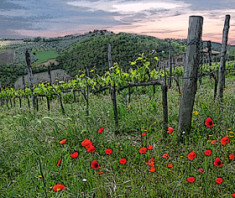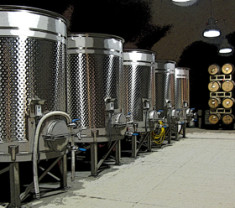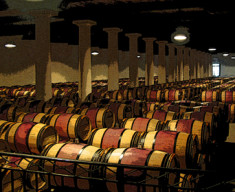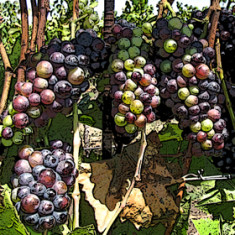Who Put The Bop In The Bop Shoo-Bop Shoo-Bop?
or “Where Do All Those Wonderful Flavors Come From!”
Chapter Ten. Part One.
 Regular followers of WineSnark have learned how to discern and describe the varied vagaries of vino but have you ever wondered where these peculiarities come from? Why does Syrah from the Rhone Valley taste different from Shiraz produced in Australia? (Syrah and Shiraz are the same grape variety but our spell buds perceive them differently). Where does the “butter” flavor come from in some Chardonnays? How come Cabernet Sauvignon can taste like blackberries or like vanilla? What makes Pinot Noir taste different from Pinot Gris?
Regular followers of WineSnark have learned how to discern and describe the varied vagaries of vino but have you ever wondered where these peculiarities come from? Why does Syrah from the Rhone Valley taste different from Shiraz produced in Australia? (Syrah and Shiraz are the same grape variety but our spell buds perceive them differently). Where does the “butter” flavor come from in some Chardonnays? How come Cabernet Sauvignon can taste like blackberries or like vanilla? What makes Pinot Noir taste different from Pinot Gris?
The answer to these questions can be found in the science of winemaking. Now don’t roll your eyes and reach for the mouse. I realize the onus of this site is flavor and not geography, meteorology, botany or chemistry, but this stuff has everything to do with the quality of wine and it’s about time WineSnark examine the scientific foundation of these unique flavors. I promise to keep it simple and I won’t even use a periodic table, unless I need someplace to set my wine glass.
The origin of the flavors in wine can be traced back to these four influences.
1. Terroir
2. Fermentation
3. Oak
4. Grape variety
Many oenophiles mistakenly believe the task of interpreting flavor is totally subjective. After all, the cognitive associations taking place in the brain are based on unique personal experiences. Many observations are actually triggered by recognizable chemical compounds that exist in the grape variety or are created during fermentation or oak aging. These familiar compounds include malic acid which is present in apples and gives some wine an apple-like flavor, diacetyl, which gives butter its taste and is used to flavor margarine, and vanillic acid (vanillin), the compound that gives natural vanilla its aroma and is also used as a flavoring agent.
The flavors derived from fermentation, oak, and grape variety are well understood and even measurable, but what about the indistinct characteristics that make the wines of one region superior to the wines of another? It’s likely that two wines produced in different locations yet made from the same grape variety, vinified in the same manner and  given identical oak treatment will have marked differences in their taste. Syrah from the Rhone Valley tastes different from its Australian counterpart not because of spelling idiosyncrasies, but because of environmental idiosyncrasies known as terroir (pronounced tair-wahr).
given identical oak treatment will have marked differences in their taste. Syrah from the Rhone Valley tastes different from its Australian counterpart not because of spelling idiosyncrasies, but because of environmental idiosyncrasies known as terroir (pronounced tair-wahr).
The chemical maelstrom taking place in a fermentation vat does more than convert sugar into alcohol. Acidity, tannin, glycerin, alcohol and residual sugar levels are established, all of which effect how a wine smells,  tastes and feels. Sugar, acid and alcohol work together with elements found in the grape skins to create about 200 different chemical compounds that generate familiar aromas and flavors. Rest assured, butter flavoring isn’t added to Chardonnay like some sort of cupcake ingredient, it’s a byproduct of fermentation.
tastes and feels. Sugar, acid and alcohol work together with elements found in the grape skins to create about 200 different chemical compounds that generate familiar aromas and flavors. Rest assured, butter flavoring isn’t added to Chardonnay like some sort of cupcake ingredient, it’s a byproduct of fermentation.
Not long after merchants began storing and shipping wine in wooden barrels they discovered their wine tasted better at the end of the voyage than it did at the beginning. The science of barrel aging was born and soon winemakers learned that barrels could smooth out the rough edges of an assertive young wine or add bitter, astringent tannins to it. They also found that barrels  produced from one forest may impart flattering nuances of clove, while wood from another forest might overpower the wine with aggressive herbaceous characteristics. The vanilla characteristic present in some wine doesn’t come from a special Hershey grape clone; it’s imparted by compounds found in barrels made of oak.
produced from one forest may impart flattering nuances of clove, while wood from another forest might overpower the wine with aggressive herbaceous characteristics. The vanilla characteristic present in some wine doesn’t come from a special Hershey grape clone; it’s imparted by compounds found in barrels made of oak.
The National Grape Registry at the University of California at Davis lists over 900 types of winemaking grapes, and that only covers the United States. Most estimates put the total worldwide vitis vinifera varieties at somewhere between 5,000 and 10,000 different cultivars.  Consider the winemaker’s proclivity for blending and the number of wine styles is staggering. Different types of grapes carry flavor compounds in their skins that are unique to their genetic makeup. Pinot Noir tastes different from Pinot Gris for the same reason Granny Smith apples taste different than Macintosh apples. They belong to the same fruit genus but each is a unique cultivar or variety.
Consider the winemaker’s proclivity for blending and the number of wine styles is staggering. Different types of grapes carry flavor compounds in their skins that are unique to their genetic makeup. Pinot Noir tastes different from Pinot Gris for the same reason Granny Smith apples taste different than Macintosh apples. They belong to the same fruit genus but each is a unique cultivar or variety.
When I started this blog I imagined a simple reference guide to help others understand and describe the characteristics of different wine styles. (Little did I suspect I would venture into scatological tangents about horse dung and cat pee.) If, even in the most insignificant way, WineSnark helps you understand the complex world of wine appreciation then I will be able to go to bed at night feeling completely surprised.
Describing wine requires more than a simple discourse on the characteristics of each grape variety. To get an idea of the complex characteristics of wine, you must also understand the profound effect that fermentation, oak and terroir has on texture and flavor. As we explore these factors in future blogs you’ll find the information increasingly useful when analyzing wine, especially if you’re the guy who thinks Grenache is chocolate pastry filling, Lambrusco is mutton beer, and Charbono is Sonny Bono’s ex-wife.























Just discovered your blog! Love it.
Thanks April Amys! Be sure to check out Snarcasms where I pick lines from recent posts (after I assemble my puns and pencils).